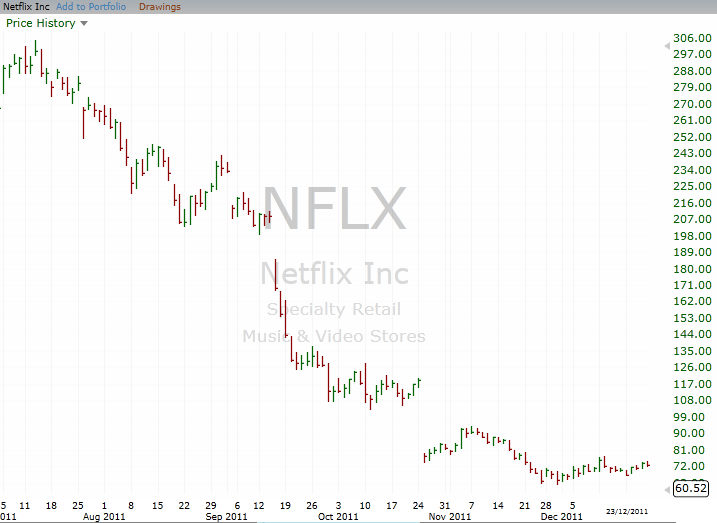Shorting stock
Shorting stock is the opposite of buying stock and is a concept that can be hard to grasp. The aim is to ‘sell high and buy low’. Shorting stock enables you to make money when the market is going down and when companies are failing, meaning that even when the economy is in recession, you can still make money!
To do this, you are first selling something that you don’t actually own – so you are actually borrowing the shares and paying interest on the borrowed shares. Then you will ultimately buy shares to repay the borrowed shares to your broker. So, you are buying and selling shares, but you are simply doing so in reverse order.
Let’s go over some examples of shorting stock. You’ll also find that it’s easier than you think to start practicing shorting stock today.
Shorting stock example
- you sell 100 shares @ $10 ($1,000)
- then buy the 100 shares back @ $9 ($900)
- and make a profit of $100!
Shorting stock example 2
The example below shows Netflix stock price fall from July 2011 until December 2011.
- Shorting stock when the price was at $300 (July 2011) by selling 10 shares at $3,000
- Buying the stock back at $75 (December 2012) by buying 10 shares at $750
- Means you would pocket the difference of $2,250! A 300% profit!

Shorting stock example 3
Another way to get your head around shorting stock!
- your friend is going on a long holiday, he lends you his car
- you then sell his car for $10,000
- you go somewhere else and buy the same model car for $9,000
- when he returns from holiday he gets the same car back and you have pocketed $1000!
Important notes regarding shorting stock
- To enable shorting stock you need a brokerage account with a margin. A margin will enable you to effectively borrow money, which what you need to do to sell a share then and then buy it back again.
- Your broker will charge you interest on the money borrowed from them to short your stock.
- When short selling stock, instead of receiving the dividend, you will sometimes have to pay it to the company, but as long as you are aware of when companies pay their dividends it shouldn’t be a problem.
- If the trade goes against you (i.e. the price goes up) your broker may make a margin call, which means you will have to add more funds to your account to cover the purchase of the share at its current price.
Start practicing today!
Why not practice shorting stock with a free stock market fantasy trading account. There’s no risk because you can trade with virtual money before you’re ready to move on to real money.
Click here to read our reviews of the different fantasy trading accounts…


If you are selling stock and buying it back for less, why do you need to borrow anything?
Hi Cal – This is because you are doing things in reverse order when you short stock and you are selling shares before you’ve actually bought them. As such, you are selling something you don’t have. The only way to sell something you don’t have is to borrow it. When you ultimately buy the shares, you are not ending up owning them – you are buying them to repay your debt of those shares.
i m little doubtful about the percentage calculated in example 2 i.e. 75. i think it is 300 perc. as it is always calculated on cost price.
plz let me know if this is wrong.
thanks!
Dipak – You are absolutely correct. Good catch and I’ve updated the page accordingly. Thanks for spotting that.